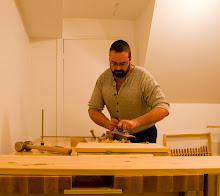 Above we see a container of methyl hydrate, which is a very pure (but very poisonous, and probably carcinogenic) alcohol, flanked by two jars. One has my mixed shellac and the other is full of un-mixed shellac flakes. Shellac flakes, properly stored, will keep for years. Once mixed it will begin losing its ability to cure in about a year, the books say.
Above we see a container of methyl hydrate, which is a very pure (but very poisonous, and probably carcinogenic) alcohol, flanked by two jars. One has my mixed shellac and the other is full of un-mixed shellac flakes. Shellac flakes, properly stored, will keep for years. Once mixed it will begin losing its ability to cure in about a year, the books say.Shellac can be mixed in different strengths. For a wash-coat you want a one-pound-cut which means one pound of shellac dissolved in one gallon of alcohol. This equates to one ounce, by weight, of shellac in one cup of alcohol. I weighed an ounce of shellac, and added it to a cup of alcohol in a jam jar. Plastic or glass is fine to store shellac. Metal isn't. Every fifteen minutes or so for an hour I'd give the jar a swirl to help the flakes dissolve. You could shake the jar, but there's always that chance that you might seal the lid shut from the inside if you get shellac up that high in the jar, so I just swirl it. Then I let it sit over night to settle. This will allow any dirt, bits of bugs, and wax to settle out. In the morning I pour a bit of the clear stuff at the top into a bowl and wipe it on the prepared, previously-wiped-again-with-mineral-spirits-and-a-clean-rag sofa table top with a clean cloth. Job done.
An hour later the top is ready to have the pores filled. This I have never done. At all. I checked my books and got at it. I mixed up some water putty into a thin paste. Water putty is similar to shellac flakes in that in its dry form it lasts for ages. You mix it with water (surprise!) and the powder can be mixed as thick or thin as you want.
 Once my putty was mixed up I wanted to darken it. The fastest way to darken something is using carbon-black, and the most accessible form of that, for me, is india ink. I added some to the putty, and that made it a dark gray, but I wanted something vaguely reddish-brownish so I added some burnt-sierra artists colour. For a water-based mixture like this you could use acrylic colour, but I have a weird water-mixable oil colour that has the benefit of being mixable in either oil or water, so I don't have to worry quite as much about putting the wrong colour somewhere. If I had been able to find dry pigments I would have gone that route instead.
Once my putty was mixed up I wanted to darken it. The fastest way to darken something is using carbon-black, and the most accessible form of that, for me, is india ink. I added some to the putty, and that made it a dark gray, but I wanted something vaguely reddish-brownish so I added some burnt-sierra artists colour. For a water-based mixture like this you could use acrylic colour, but I have a weird water-mixable oil colour that has the benefit of being mixable in either oil or water, so I don't have to worry quite as much about putting the wrong colour somewhere. If I had been able to find dry pigments I would have gone that route instead.Anyway, I mixed the colour in and applied the paste to the table top with a swirling motion to force the paste into the pores of the wood.

I waited about 15 minutes and then wiped as much of it off as I could. If I had been thinking I would have wiped the edges while it was still wet to make sure none of the putty was over-hanging. As it was it was quite irritating to remove the dried putty from the finished surfaces.
After wiping off the excess I allowed the table to dry over night, then sanded it by hand with 180 grit in the direction of the grain to remove the raised grain and putty residue.

5 comments:
You should get some tongue depressors to mix stuff up.
Actually I'm undecided whether to use disposable plastic spoons for the job. That way I can transfer liquids to a degree, as well. I'm not sure they will be strong enough, though, which is why I'm, as yet, undecided.
M.Mike
Leave the plastic spoons in the store. They are useless for mixing up things. I have even had them bust while mixing up egg salad (I hate washing cutlery).
Tongue depressors are stronger IMO.
Nice post about "Refinishing the Sofa Table Top -- Seal and fill the pores". i was looking for such an awesome post.thanks for the posting.
Old metal spoons from a Value Village/Goodwill type store would work well enough.
Post a Comment